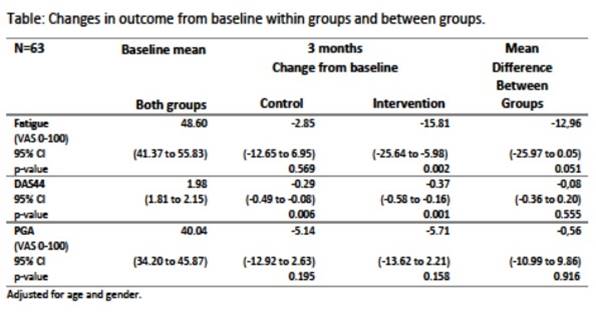Session Information
Date: Wednesday, November 8, 2017
Title: Spondyloarthropathies and Psoriatic Arthritis – Clinical Aspects and Treatment V
Session Type: ACR Concurrent Abstract Session
Session Time: 11:00AM-12:30PM
Background/Purpose: Patients with psoriatic arthritis (PsA) have a high disease burden with increased pain and more fatigue than the general population. Physical exercise is recommended for arthritis patients, although little research has been done assessing its utility. A pilot study suggests decreased disease activity in patients with spondyloarthritis (1) after high intensity interval training (HIIT).
The primary aim of this study was to measure the efficacy of HIIT on fatigue, secondly the efficacy on disease activity in PsA.
Methods: PsA patients satisfying CASPAR criteria were recruited from clinics to this randomized clinical trial. The intervention group (N=32) performed HIIT, defined as 4 times 4 minutes supervised training at 85-95% of maximum heart rate on a stationary bicycle twice a week, in addition to one additional self-guided HIIT session a week for 11 weeks. The control group (N=31) was instructed not to change their pre-study physical exercise habits during 11 weeks of the study. Before the intervention period, all participants tested their maximum heart rate and VO2max.
Fatigue and Patient Global Assessment (PGA) of overall disease activity were measured on a 100 mm VAS. Activity of arthritis was measured by DAS44. Measurements were performed at baseline and at 3 months. Mean differences within and between groups were analyzed using linear mixed models.
Results: Of the 63 patients included, 29 in the intervention group and 28 in the control group completed the trial period. Mean (SD) age was 51(11) years in the intervention group and 45(12) years in the control group. The proportion of women was 68% in the intervention group and 63% in the control group. HIIT was associated with reduced fatigue at 3 months (mean difference 12.95; 95% CI -25.97 to 0.05), and changed from 48.6 to 32.8 (p=0.002) in the intervention group; from 48.6 to 45.8 (p=0.569) in the control group. There was no effect of HIIT on DAS44 (mean difference 0.08; 95% CI -0.36 to 0.20) or PGA (mean difference 0.56; 95% CI -10.99 to 9.86). DAS44 was reduced from 1.98 to 1.61 (p=0.001) in the intervention group and from 1.98 to 1.69 (p=0.006) among controls, whereas PGA declined from 40.0 to 34.3 (p=0.158) in the intervention group and from 40.0 to 34.9 (p=0.195) in controls. Medication did not change during the study period.
Conclusion: Fatigue was significantly reduced at 3 months in the intervention group. HIIT was well tolerated in PsA patients concerning disease activity measured by DAS44 and PGA. This study suggests that HIIT may be of benefit to PsA patients. Thus, HIIT could be an important contribution to cost-efficient treatment strategies as supplementary to medical treatment for this group of patients. References: 1Sveaas S. et al: Efficacy of High Intensity Exercise on Disease Activity and Cardiovascular Risk in Active Axial Spondyloarthritis: A Randomized Controlled Pilot Study. PLOS ONE 2014 Sep 30;9(9):e108688.
To cite this abstract in AMA style:
Thomsen RS, Nilsen TIL, Haugeberg G, Bye A, Kavanaugh A, Hoff M. Less Fatigue in Psoriatic Arthritis after High Intensity Interval Training. a Randomized Controlled Trial [abstract]. Arthritis Rheumatol. 2017; 69 (suppl 10). https://acrabstracts.org/abstract/less-fatigue-in-psoriatic-arthritis-after-high-intensity-interval-training-a-randomized-controlled-trial/. Accessed .« Back to 2017 ACR/ARHP Annual Meeting
ACR Meeting Abstracts - https://acrabstracts.org/abstract/less-fatigue-in-psoriatic-arthritis-after-high-intensity-interval-training-a-randomized-controlled-trial/

